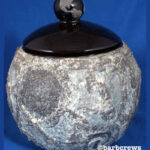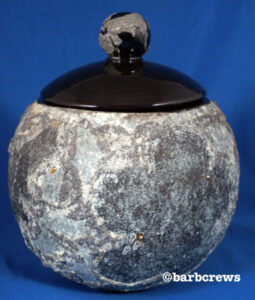Although the name Garriott might be familiar to you, it’s probably not in the context of pottery and cookie jars. Well, that’s about to change. Earlier this spring I had a chance to chat with Helen Garrott about her family, cookie jars and even a children’s science museum.Helen Garriott has the distinction of being both the (former) wife of an astronaut, Skylab astronaut Dr. Owen Garriott, and the mother of Richard Garriott, a space traveler to the International Space Station in 2008.

When I recently had the chance to purchase a an Earth Rise cookie jar, it put me on the trail to find out more about the jar and hopefully the person who made them. Thanks to Robert Pearlman of CollectSpace.com I was able to get in touch with Helen and find out more about her amazing jars.
It was in the days of NASA when the United States did the lunar landings that Earth Rise Pots were first produced. Although it’s thought that there were not many Earth Rise Pots made, Helen quickly corrected that and said she felt there was probably a pot somewhere in every country in the world, as so many were bought and shipped worldwide. These were produced in five different sizes, all handmade and fired in one of three home kilns. To designate the size of pots when people were ordering, they were referred to as baseball, soft ball, cantaloupe, musk-melon, and basketball size. Looking back, from a collector’s point of view, the jars were bargains at the time, selling from $10. for the smallest jars, up to $30. for the largest jar.
Helen said her hobby was ceramics and since they lived near the University of Houston at Clear Lake, she decided to get her masters degree in Art in the Humanities, with an emphasis on ceramics. She turned their garage into a studio and one evening her husband Owen suggested that she make “something about space”.
She found a lidded pot form that came in five sizes and after several tries came up with the design for the pot that is the landscape of the moon, with the earth as the finial on the top. The pot or jar is made to resemble one standing on the moon, looking across the blackness of space at the earth in the distance.
Since NASA had recently circled the moon, she knew what the back side looked like and could incorporate that into the design. Helen said that the hardest part was getting the lids to fit properly. The relief picture of the earth finial was all done by hand with a small brush. After several designs, the jar evolved into one made with footprints at the site of the first landing and tiny rhinestones at each of the six manned landing sites. The first landing site has three footprints, as well as a rhinestone. (can you find the footsteps?)

There were several thousand of the Earth Rise Pots produced. These were all handmade and put through two firings, making each slightly different from the other. The unusual rough texture was made by using sand in a glaze that bubbled a bit in the firing.
The Earth Rise Pots, aka as Moon Pots, were sold from Garriott’s studio house and a small gift shop, Swan Gallery, in League City Texas.
Helen also made Moon Chips, little disks which could be put on a tiny easel or worn around the neck as a pendant. These were a replica of the side of the moon as seen from earth. As with the Earth Rise Pots, she put the footprints and rhinestones at the landing sites. Another item Helen made was a few smaller bolos for men, a popular item at the time. After a while the pots and disks became so popular that Helen said she either had to quit or go into business for real. She rented a small house in Seabrook, Texas, about 15 miles from their home, bought another kiln and hired help.
She was in business.
Helen Garriott is also an accomplished oil painter and silversmith, teaching that as well. And Helen is still teaching ceramics today.
When they were doing the firings, Helen would get in the family car and drive out to Seabrook to make sure that the kilns shut off. This was usually around 2 a.m. in the morning and a drive made nearly every other night.
Helen recalls how NASA put a “squawk box” in the family home when the astronaut was in space, so that the family could talk in real time when the astronauts were near a communication station. She said when Owen was on the Sky Lab for two months, NASA also put a box at the shop. Everyone working there enjoyed hearing the communications.
Helen related, “one day a big dinner was planned by the mayor of Houston celebrating the lunar landing. They ordered over a thousand Moon Chips as souvenirs. Of course they wanted them yesterday. I hired the Clear Creek Cross Country Track Team, my son and his friends were members, to come help make them. They had to run 25 miles a day for track. We discovered if they ran from school to the shop it was about 12 miles. Then running back they had close to their 25 miles. As the date to have them finished drew closer, we had to rush. They said, “Mrs Garriott, if you will let us work all night here we will have them all done in the morning”. I was exhausted and I couldn’t stay up with them so I asked the police station down the street if they would check in on them and make sure they were all right. They assured me they would. The kids brought their music with them and in the morning they had the nicest pile of moon chips done you ever saw. We packed and delivered them on time.”
Candy Dishes
During this same time period Helen also made candy dishes which were only given to their Astronaut family friends. The Solar Candy Dishes were hand delivered to the other astronauts homes and only astronaut families received these, they were never sold. It’s rare to find these dishes and Garriott says she doesn’t even have one.
Read more about Helen Garriott:
Values: $$
From the @barbcrews archives 2011


